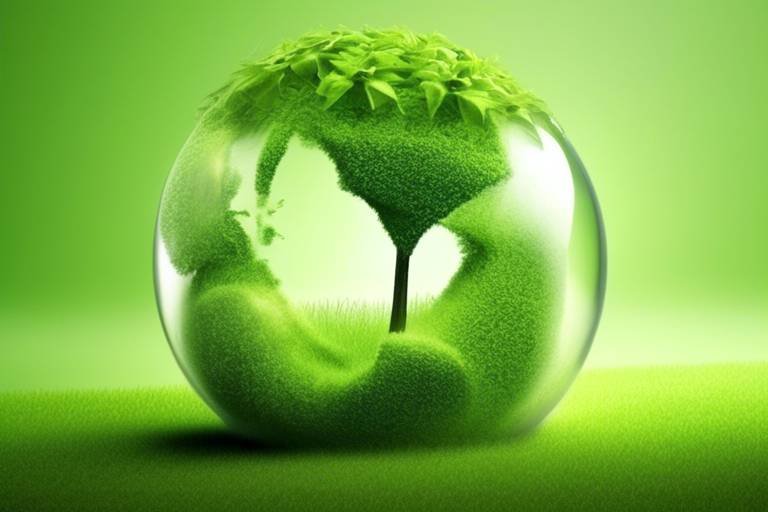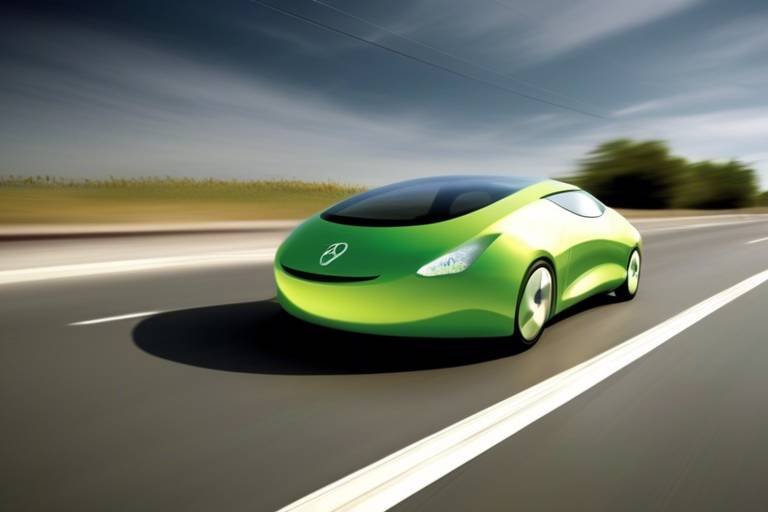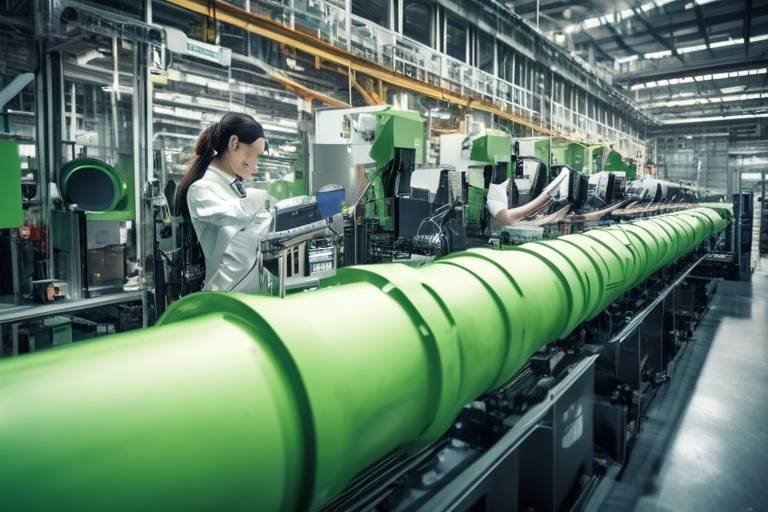The Role of Biotechnology in Eco-Friendly Innovations
In today's world, where environmental challenges loom large, the role of biotechnology has emerged as a beacon of hope for sustainable practices and innovations. Imagine a world where we can grow food with less water, produce energy without polluting the air, and clean up our planet's messes using nature's own tools. Sounds like science fiction, right? Well, it's becoming a reality thanks to the incredible advancements in biotechnology. This field isn't just about test tubes and lab coats; it's about harnessing the power of living organisms to create solutions that benefit both humanity and the environment.
Biotechnology is making waves across various sectors, from agriculture to energy and waste management. It's like a Swiss Army knife for sustainability, offering a range of tools and techniques that can transform how we interact with our planet. By integrating biological processes into our daily practices, we can significantly reduce our ecological footprint while enhancing productivity. But how exactly does biotechnology contribute to eco-friendly innovations? Let’s dive deeper into some of its most impactful applications.
One of the most significant impacts of biotechnology is in the realm of sustainable agriculture. Traditional farming methods often require vast amounts of water, fertilizers, and pesticides, leading to soil degradation and water scarcity. However, biotechnology is revolutionizing this landscape by developing crops that are not only more resilient but also require fewer resources. Think of crops that can thrive in drought conditions or ones that can fend off pests without the need for harmful chemicals. This is not just wishful thinking; it’s happening!
With genetically modified organisms (GMOs), farmers can cultivate crops that are engineered to resist diseases and adapt to changing climates. This means higher yields and less reliance on chemical treatments, which ultimately leads to a healthier ecosystem. Imagine walking through a field of corn that not only grows faster but also uses half the water. That’s the power of biotechnology in action!
Another exciting area where biotechnology shines is in the production of biofuels. As the world grapples with climate change, the need for renewable energy sources has never been more critical. Biofuels, produced through biotechnological processes, offer a sustainable alternative to fossil fuels. By converting organic materials into energy, we can reduce greenhouse gas emissions and promote a cleaner energy landscape. It’s like turning waste into wealth!
One particularly innovative approach is the use of microbial fuel cells. These remarkable devices harness the power of bacteria to convert organic matter into electricity. This not only provides a renewable energy source but also addresses waste management challenges. Imagine powering your home with the waste that you would typically throw away—how cool is that? It’s a perfect example of how biotechnology can tackle multiple issues at once.
Biotechnology also plays a crucial role in enhancing wastewater treatment processes. By employing microorganisms to break down pollutants, we can achieve cleaner water and significantly reduce environmental contamination. This sustainable approach not only safeguards our water resources but also promotes a healthier ecosystem. Think of it as nature's own recycling system, working tirelessly to restore balance.
Furthermore, bioremediation techniques utilize living organisms to clean up contaminated environments. Whether it’s oil spills or heavy metal contamination, these techniques effectively remove hazardous substances from soil and water, showcasing the power of nature in restoring ecological balance. It’s like having a team of tiny superheroes working to save our planet!
Moreover, genetic engineering techniques are being employed to enhance the resilience of endangered species. By supporting biodiversity and ecosystem stability, these efforts play a vital role in conservation. Imagine a world where endangered species can thrive again, thanks to the advancements in biotechnology. It’s a hopeful vision for the future!
Innovative biotechnological solutions are revolutionizing waste management. By converting organic waste into valuable resources, we can reduce landfill use and promote a circular economy. This not only benefits the environment but also society as a whole. It’s like turning trash into treasure!
Processes like composting and anaerobic digestion transform organic waste into nutrient-rich fertilizers and biogas. These sustainable waste management practices enhance soil health and energy production, creating a win-win situation for both farmers and the environment. Just imagine the potential when we start viewing waste as a resource rather than a problem!
Additionally, biotechnology is being explored to develop microorganisms capable of degrading plastics. With the global plastic pollution crisis at our doorstep, these potential solutions could pave the way for biodegradable alternatives, offering a glimmer of hope in the battle against plastic waste.
The future of biotechnology holds immense promise for eco-friendly innovations. As ongoing research and development continue to uncover new methods and applications, we can expect to see even greater enhancements in sustainability across various sectors. The possibilities are endless, and with each breakthrough, we move closer to a greener, more sustainable world.
- What is biotechnology? Biotechnology is the use of living organisms or their systems to develop or create products, often aimed at improving human life and the environment.
- How does biotechnology help in agriculture? It helps by developing crops that are resistant to pests and diseases, require less water, and can adapt to changing climates.
- What are biofuels? Biofuels are renewable energy sources made from organic materials, offering a sustainable alternative to fossil fuels.
- Can biotechnology help with plastic pollution? Yes, researchers are exploring microorganisms that can degrade plastics, providing potential solutions to this pressing issue.

Biotechnology in Sustainable Agriculture
Biotechnology is transforming the landscape of agriculture, serving as a powerful tool in the quest for sustainable farming practices. Imagine a world where crops not only flourish in challenging conditions but also require fewer resources to thrive. This is the promise of biotechnology. By harnessing the principles of genetic engineering, scientists are developing crops that are not only more resilient to pests but also capable of adapting to the ever-changing climate. This advancement is crucial in a time when traditional farming methods are often unsustainable and can lead to significant environmental degradation.
One of the most remarkable aspects of biotechnological innovations in agriculture is their ability to reduce the reliance on chemical pesticides and fertilizers. For instance, genetically modified organisms (GMOs) can be engineered to express traits that make them resistant to specific pests, thereby minimizing the need for harmful chemicals. This approach not only protects the crops but also promotes a healthier ecosystem by reducing pesticide runoff into waterways. The benefits extend beyond just pest resistance; biotechnology also plays a significant role in enhancing nutritional content, which is vital for combating malnutrition in various parts of the world.
Furthermore, biotechnology aids in the development of crops that can thrive in suboptimal conditions, such as drought or salinity. With climate change posing a significant threat to food security, the ability to cultivate crops that can withstand these challenges is more important than ever. Consider the following advancements:
- Drought-Resistant Varieties: Crops like drought-tolerant maize have been developed to withstand prolonged dry spells, ensuring food production even in arid regions.
- Salt-Tolerant Crops: Research is underway to create rice varieties that can grow in saline soils, opening up new agricultural lands that were previously considered unusable.
Moreover, biotechnology fosters sustainable practices by promoting crop rotation and reduced tillage, which help maintain soil health. By integrating biotechnological methods with traditional farming practices, farmers can enhance soil structure, increase organic matter, and improve water retention. This holistic approach not only boosts crop yields but also contributes to the long-term viability of agricultural systems.
As we look to the future, the potential of biotechnology in sustainable agriculture appears limitless. Ongoing research is focused on developing even more innovative solutions, such as precision agriculture technologies that utilize data analytics and biotechnology to optimize farming practices. These advancements promise to create a more efficient agricultural system that can meet the demands of a growing global population while minimizing environmental impact.
In conclusion, biotechnology is not just a buzzword; it is a vital component of sustainable agriculture. By embracing these innovations, we can work towards a future where farming is not only productive but also environmentally responsible. As we continue to explore the vast potential of biotechnology, we must remain committed to ethical practices that prioritize the health of our planet and its inhabitants.
Q1: What is biotechnology in agriculture?
A1: Biotechnology in agriculture involves using scientific tools and techniques, including genetic engineering, to enhance the growth, resistance, and nutritional value of crops.
Q2: How does biotechnology reduce the use of pesticides?
A2: By developing crops that are genetically resistant to pests, biotechnology minimizes the need for chemical pesticides, leading to a healthier ecosystem.
Q3: Can biotechnology help with climate change?
A3: Yes, biotechnology can create crops that are more resilient to climate-related challenges, such as drought and salinity, ensuring food security in changing conditions.
Q4: What are GMOs?
A4: Genetically Modified Organisms (GMOs) are organisms whose genetic material has been altered using biotechnology to exhibit desired traits, such as pest resistance or improved nutrition.
Q5: Is biotechnology safe for the environment?
A5: When used responsibly and ethically, biotechnology can promote sustainable practices that protect the environment while enhancing agricultural productivity.

Biofuels and Renewable Energy
When we talk about the future of energy, biofuels are often at the forefront of the conversation. Why? Because they represent a sustainable alternative to fossil fuels, which have long been the backbone of our energy consumption. Imagine a world where our cars, planes, and even homes run on energy derived from plants and waste. Sounds like science fiction, right? But the truth is, biofuels are already making waves in the renewable energy sector, and their potential is enormous.
Biofuels are created from organic materials, such as crops, agricultural waste, or even algae. The beauty of biofuels lies in their ability to reduce greenhouse gas emissions significantly compared to traditional fossil fuels. For instance, using bioethanol in your vehicle can cut down carbon dioxide emissions by as much as 60%. This is a game changer in our fight against climate change!
One of the most exciting aspects of biofuels is their versatility. They can be used in various forms, including:
- Biodiesel: Made from vegetable oils or animal fats, biodiesel can be used in diesel engines with little to no modifications.
- Bioethanol: This alcohol-based fuel is often blended with gasoline, reducing reliance on pure fossil fuels.
- Biogas: Produced through the anaerobic digestion of organic matter, biogas can be used for heating, electricity, or even as a vehicle fuel.
But how do we produce these biofuels? The process generally involves several stages:
| Stage | Description |
|---|---|
| Feedstock Collection | Gathering organic materials like crops, waste, or algae. |
| Processing | Converting the feedstock into fuel through chemical or biological methods. |
| Refinement | Purifying the fuel to meet quality standards for use in vehicles and machinery. |
| Distribution | Transporting the fuel to consumers, similar to traditional fossil fuels. |
Moreover, biofuels can play a critical role in creating a circular economy. By utilizing waste products, we can reduce landfill use while simultaneously producing energy. Think about it: instead of throwing away food scraps or agricultural waste, we can turn them into fuel! This not only conserves resources but also contributes to a more sustainable future.
However, it's essential to approach biofuel production responsibly. Not all biofuels are created equal. For instance, the cultivation of certain crops for biofuel can lead to deforestation or competition with food production. Thus, ongoing research is crucial to ensure that we maximize the benefits of biofuels while minimizing any negative impacts on the environment.
In conclusion, biofuels represent a significant step toward a more sustainable energy future. They offer an innovative solution to our growing energy needs while helping to combat climate change. As technology advances, we can expect to see even more efficient and eco-friendly biofuel options emerging, paving the way for a cleaner, greener planet.
- What are biofuels? Biofuels are renewable energy sources made from organic materials, such as plants and waste.
- How do biofuels reduce greenhouse gas emissions? They produce significantly lower emissions compared to fossil fuels during combustion.
- Can I use biofuels in my vehicle? Yes, many vehicles can run on biodiesel or bioethanol with little to no modifications.
- What are the environmental impacts of biofuel production? Responsible production can minimize negative effects, but some practices may lead to deforestation or food competition.

Microbial Fuel Cells
Microbial fuel cells (MFCs) represent a fascinating intersection of biology and technology, harnessing the natural power of bacteria to generate electricity. Imagine a tiny power plant nestled within the confines of organic waste, where microorganisms break down matter and, in the process, release electrons that can be captured as electrical energy. This innovative approach not only produces renewable energy but also addresses the pressing challenge of waste management. The dual benefit of MFCs makes them a game-changer in our quest for sustainable solutions.
In essence, microbial fuel cells work by using specific bacteria that can metabolize organic compounds. These bacteria thrive in anaerobic (oxygen-free) environments, which are commonly found in landfills and wastewater treatment facilities. As they break down organic materials, they transfer electrons to an anode, creating a flow of electricity. This process can be likened to a natural battery, where the organic waste serves as both food and fuel for the bacteria. The generated electricity can power small devices or be fed into the grid, contributing to the renewable energy landscape.
One of the most exciting aspects of MFC technology is its versatility. They can be deployed in various settings, from rural areas with limited access to electricity to urban centers grappling with waste management issues. Here are some key applications:
- Wastewater Treatment: MFCs can significantly enhance the efficiency of wastewater treatment plants by generating electricity while simultaneously treating sewage.
- Remote Power Generation: In remote locations, MFCs can provide a sustainable energy source for devices, sensors, or even small communities.
- Bioremediation: These cells can help clean up contaminated sites by breaking down pollutants while producing energy.
Moreover, the environmental benefits of microbial fuel cells extend beyond energy production. By utilizing organic waste, MFCs contribute to reducing landfill use and greenhouse gas emissions. This aligns perfectly with the principles of a circular economy, where waste is seen not as a problem but as a resource. The ability to convert waste into energy exemplifies how biotechnology can lead to innovative solutions that are both eco-friendly and economically viable.
Despite their promise, microbial fuel cells face several challenges that need to be addressed for widespread adoption. Issues such as cost, scalability, and efficiency must be tackled through ongoing research and development. Scientists are exploring ways to enhance the performance of MFCs by optimizing bacterial strains and improving electrode materials. The table below outlines some of the current challenges and potential solutions:
| Challenge | Potential Solution |
|---|---|
| High production costs | Development of cheaper materials and processes |
| Low power output | Genetic engineering of bacteria for enhanced performance |
| Scalability issues | Designing larger, more efficient systems |
As research progresses, the future of microbial fuel cells looks promising. With advancements in biotechnology, we may soon see MFCs becoming a common feature in our waste management systems and energy production strategies. The potential to create a cleaner, more sustainable world through the application of microbial fuel cells is not just a dream; it is a tangible goal within our reach.
- What are microbial fuel cells?
Microbial fuel cells are devices that use bacteria to convert organic matter into electricity. - How do microbial fuel cells work?
Bacteria break down organic compounds, releasing electrons that can be captured as electrical energy. - What are the benefits of using microbial fuel cells?
They provide renewable energy, enhance waste management, and reduce greenhouse gas emissions. - What challenges do microbial fuel cells face?
Challenges include high production costs, low power output, and scalability issues.

Applications in Wastewater Treatment
Wastewater treatment is a critical aspect of environmental management, and biotechnology is leading the charge in transforming how we approach this challenge. By employing microorganisms, biotechnology enhances traditional treatment processes, making them more efficient and effective. Imagine a world where dirty water can be transformed into clean, reusable water through the magic of tiny living organisms. This is not just a dream; it's becoming a reality thanks to biotechnological innovations.
One of the most significant applications of biotechnology in wastewater treatment is the use of microbial communities that can break down complex pollutants. These microorganisms, often referred to as biofilms, attach themselves to surfaces within treatment systems and form a dense layer of bacteria. As wastewater flows through, these bacteria feast on organic matter, breaking it down into simpler, less harmful substances. This process not only purifies the water but also reduces the need for harsh chemicals that can be detrimental to the environment.
In addition to biofilms, biotechnology also employs genetically engineered microorganisms that can target specific contaminants. For example, scientists have developed strains of bacteria that can effectively degrade heavy metals or pharmaceuticals found in wastewater. This targeted approach means that treatment facilities can achieve higher removal rates with fewer resources, ultimately leading to cleaner water being released back into the environment.
Another fascinating aspect of biotechnological applications in wastewater treatment is the concept of constructed wetlands. These systems mimic natural wetlands, using plants and microorganisms to filter and purify water. As the wastewater flows through the wetland, it is naturally treated by the plants and microbes, which absorb nutrients and break down pollutants. This method not only cleans the water but also creates a habitat for wildlife, demonstrating how biotechnology can harmonize human needs with ecological health.
To illustrate the effectiveness of these biotechnological approaches, consider the following table that compares traditional wastewater treatment methods with biotechnological innovations:
| Aspect | Traditional Treatment | Biotechnology-Enhanced Treatment |
|---|---|---|
| Efficiency | Moderate | High |
| Use of Chemicals | High | Low |
| Energy Consumption | High | Lower |
| Environmental Impact | Higher | Lower |
As we can see, biotechnological methods not only enhance the efficiency of wastewater treatment but also significantly reduce the environmental impact. This is crucial in a world where water scarcity and pollution are pressing issues. By embracing these innovative approaches, we can make strides towards a more sustainable future.
In conclusion, the applications of biotechnology in wastewater treatment are vast and varied. From microbial communities breaking down pollutants to constructed wetlands providing natural filtration, the potential for improving water quality is immense. As we continue to explore and invest in these technologies, we can look forward to a future where clean water is accessible to all, and our ecosystems are preserved.
- What is biotechnology in wastewater treatment? Biotechnology in wastewater treatment refers to the use of microorganisms and biological processes to treat and purify wastewater, making it safe for release into the environment.
- How do microorganisms help in wastewater treatment? Microorganisms break down organic matter and pollutants in wastewater, converting them into less harmful substances and improving water quality.
- What are constructed wetlands? Constructed wetlands are engineered systems that mimic natural wetlands, using plants and microorganisms to filter and treat wastewater effectively.
- Are biotechnological methods more expensive than traditional methods? While the initial investment in biotechnological systems may be higher, they often lead to lower operational costs and reduced environmental impact in the long run.

Bioremediation Techniques
Bioremediation techniques are a fascinating intersection of nature and technology, harnessing the power of living organisms to tackle environmental pollution. Imagine a world where the soil and water can heal themselves, thanks to tiny microbes working diligently to break down hazardous substances. This approach not only cleans up contaminated sites but also restores ecological balance, making it a vital tool in our quest for sustainability.
At its core, bioremediation involves using microorganisms, such as bacteria and fungi, to degrade or transform pollutants into less harmful substances. This process can occur naturally or be enhanced through biotechnology. For instance, certain bacteria can metabolize oil spills, breaking down the hydrocarbons into harmless byproducts. This method is not only effective but also eco-friendly, as it minimizes the need for chemical treatments that can further harm the environment.
There are two primary types of bioremediation: in situ and ex situ. In situ bioremediation takes place at the site of contamination, allowing the natural processes to unfold without disturbing the environment. This method is often less expensive and less disruptive. On the other hand, ex situ bioremediation involves removing contaminated material to treat it elsewhere. This approach can be more controlled and may yield faster results, but it can also be more costly and labor-intensive.
Some common bioremediation techniques include:
- Biostimulation: This technique involves adding nutrients or other substances to stimulate the growth of existing microorganisms in the contaminated environment. By providing the right conditions, we can encourage these tiny helpers to multiply and break down pollutants more effectively.
- Bioaugmentation: In this method, specific strains of microorganisms are introduced to the contaminated site to enhance the degradation process. This can be particularly useful when native microbes are insufficient to tackle the specific pollutants present.
- Phytoremediation: This innovative technique utilizes plants to absorb, accumulate, or degrade pollutants from soil and water. Certain plants have the remarkable ability to take up heavy metals or organic contaminants, effectively cleaning the environment while also providing additional benefits, such as habitat restoration.
One of the most exciting aspects of bioremediation is its adaptability. Researchers are constantly discovering new microorganisms and developing advanced techniques that can target a wide range of pollutants, from heavy metals to pesticides. For example, scientists are exploring the potential of genetically engineered bacteria that can degrade plastics, addressing one of the most pressing environmental challenges of our time.
In summary, bioremediation techniques represent a beacon of hope in the fight against pollution. By leveraging the natural abilities of microorganisms, we can clean up our planet in a sustainable and effective manner. As we continue to innovate and refine these methods, the potential for restoring contaminated environments and promoting ecological health becomes increasingly attainable.
- What is bioremediation? Bioremediation is the process of using living organisms, primarily microorganisms, to remove or neutralize contaminants from the environment.
- How does bioremediation work? It works by harnessing the natural metabolic processes of microorganisms to break down pollutants into less harmful substances.
- What are the types of bioremediation? The two main types are in situ (at the contamination site) and ex situ (removing contaminated material for treatment).
- Is bioremediation effective for all types of pollutants? While bioremediation is effective for many pollutants, its success can depend on the specific contaminants and environmental conditions.
- What are some examples of bioremediation techniques? Common techniques include biostimulation, bioaugmentation, and phytoremediation.

Genetic Engineering for Conservation
In the face of rapid environmental changes and the alarming rate of species extinction, genetic engineering emerges as a beacon of hope for conservation efforts. This advanced technology allows scientists to manipulate the genetic makeup of organisms, enhancing their resilience to threats such as climate change, habitat loss, and disease. Imagine a world where endangered species can adapt to their changing environments, much like how a chameleon changes its colors to blend in with its surroundings. This is the potential that genetic engineering holds for biodiversity preservation.
One of the most exciting applications of genetic engineering in conservation is the development of genetically modified organisms (GMOs) that possess traits crucial for survival. For instance, researchers are exploring ways to engineer plants that can thrive in arid conditions, enabling them to flourish in regions severely affected by drought. This not only supports the plant species but also the entire ecosystem that relies on them for food and shelter. By enhancing the adaptability of these species, we can help maintain ecological balance and support a diverse range of wildlife.
Moreover, genetic engineering can aid in the restoration of habitats that have been severely degraded. By introducing genetically modified organisms that can tolerate harsh conditions, we can revitalize ecosystems that have lost their native flora and fauna. For example, scientists are working on developing tree species that can grow in polluted soils, effectively cleaning the environment while providing habitats for various creatures. This approach not only addresses immediate environmental issues but also fosters long-term ecological health.
However, the use of genetic engineering in conservation is not without its challenges. Ethical considerations and potential ecological impacts must be carefully evaluated. It is crucial to ensure that genetically modified organisms do not disrupt existing ecosystems or outcompete native species. To mitigate these risks, rigorous testing and monitoring are essential before any release into the wild. The goal is to create a harmonious balance where technology aids nature, rather than imposes upon it.
As we look to the future, the integration of genetic engineering into conservation strategies could revolutionize how we approach biodiversity preservation. With ongoing research and collaboration among scientists, conservationists, and policymakers, we can harness the power of genetics to create resilient ecosystems that can withstand the pressures of a changing world. The potential for innovation in this field is vast, and with it comes the hope of preserving our planet's rich tapestry of life for generations to come.
- What is genetic engineering? Genetic engineering is the manipulation of an organism's DNA to introduce new traits or enhance existing ones.
- How does genetic engineering help conservation? It can enhance the resilience of endangered species, restore habitats, and improve the adaptability of plants and animals to environmental changes.
- Are there risks associated with genetic engineering in conservation? Yes, potential ecological impacts and ethical considerations must be addressed to prevent disruption of natural ecosystems.
- What are some examples of genetic engineering in conservation? Examples include developing drought-resistant crops and trees that can grow in polluted soils, which help restore degraded habitats.

Biotechnology in Waste Management
Innovative biotechnological solutions are revolutionizing waste management by converting organic waste into valuable resources, reducing landfill use, and promoting a circular economy that benefits both the environment and society. Imagine a world where our waste is not just discarded but transformed into something useful. This is the promise of biotechnology in waste management. By harnessing the power of living organisms, we can tackle the mounting waste crisis while simultaneously creating new opportunities for sustainability.
One of the most significant advancements in this field is the development of processes that utilize microorganisms to break down organic waste. These processes not only help in reducing the volume of waste sent to landfills but also yield byproducts that can be used as fertilizers or energy sources. For instance, anaerobic digestion is a process that employs bacteria to decompose organic matter in the absence of oxygen, producing biogas and digestate. Biogas can be harnessed for energy, while digestate serves as a nutrient-rich fertilizer, closing the loop in waste management.
Furthermore, biotechnology is paving the way for innovative solutions to one of the most pressing environmental challenges of our time: plastic pollution. Researchers are exploring the potential of genetically engineered microorganisms that can effectively degrade plastics. This could revolutionize how we approach plastic waste, transforming it from a persistent pollutant into a resource. Imagine a future where plastics are not just a nuisance but a source of energy or raw materials for new products!
To illustrate the impact of biotechnology in waste management, consider the following table that highlights some key biotechnological processes and their benefits:
| Biotechnological Process | Description | Benefits |
|---|---|---|
| Anaerobic Digestion | Breakdown of organic waste by bacteria in the absence of oxygen. | Produces biogas for energy and nutrient-rich digestate for fertilization. |
| Composting | Natural decomposition of organic matter by microorganisms. | Creates high-quality compost that enriches soil and reduces landfill waste. |
| Plastic Degradation | Use of engineered microorganisms to break down plastics. | Offers potential solutions to plastic pollution and creates biodegradable alternatives. |
As we delve deeper into the realm of biotechnology, it's essential to recognize the role of public awareness and education in fostering these eco-friendly innovations. By informing communities about the benefits of biotechnological waste management solutions, we can encourage participation and support for these initiatives. After all, sustainability is a collective effort that requires the involvement of individuals, businesses, and governments alike.
In conclusion, biotechnology is not just a scientific field; it is a beacon of hope for a sustainable future. By transforming waste into resources, we can create a cleaner, healthier planet for generations to come. The journey toward effective waste management through biotechnology is just beginning, and the possibilities are as vast as our imagination. So, let's embrace these innovations and work together to turn our waste into a valuable asset!
- What is biotechnology in waste management? Biotechnology in waste management refers to the use of biological processes, particularly involving microorganisms, to treat and convert waste into useful products.
- How does anaerobic digestion work? Anaerobic digestion is a process where bacteria break down organic materials in the absence of oxygen, producing biogas and digestate.
- Can biotechnology help with plastic waste? Yes, researchers are developing microorganisms that can degrade plastics, potentially providing solutions to plastic pollution.
- What are the benefits of composting? Composting enriches soil, reduces landfill waste, and recycles organic materials into a valuable resource.

Composting and Anaerobic Digestion
Composting and anaerobic digestion are two innovative biotechnological processes that transform organic waste into valuable resources. These methods not only help in managing waste effectively but also contribute significantly to environmental sustainability. Imagine turning your kitchen scraps and yard waste into nutrient-rich fertilizers or biogas that can power your home—this is the magic of composting and anaerobic digestion!
Composting is a natural process where microorganisms, such as bacteria and fungi, break down organic matter into a dark, crumbly substance known as compost. This process requires the right balance of carbon-rich materials (browns) and nitrogen-rich materials (greens), along with moisture and oxygen. The result? A nutrient-dense soil amendment that can enhance soil health, improve water retention, and promote plant growth. It's like giving your garden a superfood boost!
On the other hand, anaerobic digestion is a bit more complex. This process occurs in the absence of oxygen and involves the breakdown of organic materials by microorganisms to produce biogas—a mixture of methane and carbon dioxide. Biogas can be harnessed as a renewable energy source, providing an alternative to fossil fuels. This not only reduces greenhouse gas emissions but also offers a sustainable method for managing organic waste.
To visualize the differences and similarities between composting and anaerobic digestion, consider the following table:
| Feature | Composting | Anaerobic Digestion |
|---|---|---|
| Oxygen Requirement | Aerobic (requires oxygen) | Anaerobic (no oxygen required) |
| End Product | Compost (nutrient-rich soil amendment) | Biogas (renewable energy) and digestate (fertilizer) |
| Timeframe | Weeks to months | Weeks to months, depending on conditions |
| Ideal Materials | Fruit and vegetable scraps, yard waste, coffee grounds | Food waste, manure, agricultural residues |
Both composting and anaerobic digestion play a crucial role in promoting a circular economy. By recycling organic waste, we can significantly reduce landfill usage, which is a major contributor to environmental pollution. Additionally, these processes help in sequestering carbon in the soil, further mitigating climate change impacts.
Moreover, the benefits don’t stop at environmental sustainability. Engaging in composting and anaerobic digestion can lead to significant cost savings for households and businesses alike. By reducing waste disposal fees and providing free fertilizers or energy, these practices are both economically and environmentally friendly.
In conclusion, composting and anaerobic digestion represent two sides of the same coin, each offering unique advantages in the quest for sustainable waste management. As we continue to innovate and embrace these biotechnological solutions, we pave the way for a greener future where waste is no longer seen as a problem but rather as a resource waiting to be transformed.
- What can I compost? You can compost fruit and vegetable scraps, coffee grounds, eggshells, grass clippings, leaves, and small branches.
- How long does composting take? Composting can take anywhere from a few weeks to several months, depending on factors like temperature, moisture, and the materials used.
- Is anaerobic digestion safe? Yes, anaerobic digestion is a safe and effective way to manage organic waste and produce renewable energy.

Plastic Degradation Solutions
Plastic pollution is one of the most pressing environmental challenges we face today. With millions of tons of plastic waste ending up in landfills and oceans each year, finding effective solutions for plastic degradation is critical. Fortunately, biotechnology is stepping up to the plate, offering innovative and sustainable methods to tackle this issue head-on. Imagine a world where plastic waste could be transformed into harmless substances by tiny living organisms. That’s the promise of biotechnological advancements in plastic degradation!
Recent studies have revealed that certain microorganisms possess the remarkable ability to break down plastics, which traditionally take hundreds of years to decompose. These microorganisms, including specific bacteria and fungi, can metabolize plastic polymers, effectively converting them into simpler, non-toxic compounds. For instance, researchers have identified strains of Ideonella sakaiensis that can digest polyethylene terephthalate (PET), a common plastic found in bottles and containers. By harnessing these natural processes, we can significantly reduce the amount of plastic waste in our environment.
Moreover, the potential applications of these plastic-degrading microorganisms are vast. They can be utilized in various settings, from industrial waste management facilities to local composting sites. Imagine a scenario where your community can effectively manage its plastic waste through the use of specially cultivated microbes. This not only promotes a cleaner environment but also fosters a sense of responsibility towards waste management.
To better understand the impact of these biotechnological solutions, consider the following table that highlights some of the promising microorganisms and their plastic degradation capabilities:
| Microorganism | Plastic Type | Degradation Time |
|---|---|---|
| Ideonella sakaiensis | Polyethylene Terephthalate (PET) | 6 weeks |
| Aspergillus niger | Polyurethane | 3 months |
| Burkholderia cepacia | Polyethylene | 1 year |
| Mycobacterium | Polystyrene | 2 months |
While these advancements are promising, it's important to note that we are still in the early stages of understanding the full potential of these microorganisms. Research is ongoing, and scientists are exploring ways to enhance the efficiency of plastic degradation processes. This includes genetic engineering techniques that could improve the metabolic pathways of these organisms, making them even more effective at breaking down plastics.
In addition to microbial solutions, biotechnological innovations are also focusing on developing biodegradable plastics. These are designed to decompose more rapidly in natural environments, providing an alternative to conventional plastics. By investing in research and development, we can pave the way for a future where plastic pollution is significantly minimized.
In conclusion, the role of biotechnology in plastic degradation is a beacon of hope in our fight against plastic pollution. As we continue to explore and harness the power of microorganisms and innovative materials, we can create a more sustainable and eco-friendly future. The journey may be long, but the potential rewards are immense—cleaner oceans, healthier ecosystems, and a planet that can support future generations.
- What are biodegradable plastics? Biodegradable plastics are designed to break down more quickly than traditional plastics, often in a matter of months, through natural processes involving microorganisms.
- How do microorganisms degrade plastic? Certain microorganisms can metabolize plastic polymers, breaking them down into simpler, non-toxic substances that can be absorbed by the environment.
- Can biotechnological solutions completely eliminate plastic waste? While biotechnological solutions are promising, they are part of a broader strategy needed to manage plastic waste, which includes reduction, reuse, and recycling efforts.

The Future of Eco-Friendly Biotechnology
As we stand on the brink of a new era, the future of eco-friendly biotechnology is bursting with potential. Imagine a world where our agricultural practices are not just productive but also sustainable, where energy is derived from renewable sources that leave minimal footprints on our planet. This is not just a dream; it's a vision that is becoming increasingly attainable through the advances in biotechnology.
Ongoing research and development are paving the way for groundbreaking innovations that can transform various sectors. For instance, scientists are exploring the genetic modification of crops to enhance their resilience against pests and climate change. These genetically engineered crops can yield more produce with fewer resources, thereby reducing the strain on our environment. As we face the challenges of a growing population and changing climate, such innovations are not just beneficial; they are essential.
In the realm of energy, the potential of biofuels is becoming more pronounced. The production of biofuels through biotechnological processes could lead to a significant reduction in our reliance on fossil fuels. This shift not only decreases greenhouse gas emissions but also fosters a cleaner and greener energy landscape. Furthermore, the development of microbial fuel cells is a fascinating area of research. These cells utilize bacteria to convert organic matter into electricity, presenting a dual benefit of waste management and energy generation. Can you imagine harnessing the power of tiny organisms to light up our homes?
Moreover, the future of biotechnology extends into waste management. Innovative solutions are emerging that convert organic waste into valuable resources, promoting a circular economy. For example, processes like composting and anaerobic digestion are being refined to transform organic waste into nutrient-rich fertilizers and biogas. This not only enhances soil health but also contributes to energy production, creating a win-win scenario for both the environment and society.
Another exciting frontier is the development of microorganisms capable of degrading plastics. With plastic pollution reaching alarming levels, biotechnological advancements could provide much-needed solutions. Imagine a future where plastics are no longer a burden on our ecosystems but are instead broken down by specially engineered bacteria, paving the way for biodegradable alternatives.
As we look ahead, the possibilities are endless. The integration of biotechnology into eco-friendly practices is not just a trend; it's a necessity for sustaining our planet. With every breakthrough, we move closer to a world where innovation and sustainability go hand in hand. The question remains: are we ready to embrace these changes and work towards a greener future?
- What is eco-friendly biotechnology? Eco-friendly biotechnology refers to the use of biological processes and organisms to create products and solutions that are sustainable and beneficial for the environment.
- How does biotechnology contribute to sustainable agriculture? Biotechnology helps develop crops that require fewer resources, resist pests, and adapt to climate change, promoting sustainable farming practices.
- What are microbial fuel cells? Microbial fuel cells are devices that use bacteria to convert organic matter into electricity, providing a renewable energy source while managing waste.
- Can biotechnology help with plastic pollution? Yes, biotechnology is being explored to develop microorganisms that can degrade plastics, offering potential solutions to the global plastic crisis.
- What is bioremediation? Bioremediation is a process that uses living organisms to remove or neutralize contaminants from soil and water, helping to restore ecological balance.
Frequently Asked Questions
- What is biotechnology and how does it contribute to eco-friendly innovations?
Biotechnology is a field that uses living organisms or their components to develop products and processes beneficial to humans and the environment. It contributes to eco-friendly innovations by creating sustainable agricultural practices, renewable energy sources, and effective waste management solutions that minimize environmental impact.
- How does biotechnology improve sustainable agriculture?
Biotechnology enhances sustainable agriculture by developing genetically modified crops that require fewer resources, resist pests, and adapt to climate changes. This not only maximizes yield but also reduces the need for harmful pesticides and fertilizers, promoting a healthier ecosystem.
- What role do biofuels play in reducing greenhouse gas emissions?
Biofuels, produced through biotechnological processes, provide a renewable energy source that significantly reduces reliance on fossil fuels. By replacing traditional energy sources, biofuels help lower greenhouse gas emissions, contributing to a cleaner and more sustainable energy landscape.
- Can you explain microbial fuel cells and their benefits?
Microbial fuel cells utilize bacteria to convert organic matter into electricity. This innovative technology not only generates renewable energy but also aids in waste management by breaking down organic waste, making it a dual-purpose solution that benefits the environment.
- What is bioremediation and how does it work?
Bioremediation is a process that employs living organisms, such as microbes and plants, to clean up contaminated environments. These organisms break down hazardous substances in soil and water, effectively restoring ecological balance and improving environmental health.
- How does biotechnology address plastic pollution?
Biotechnology is exploring ways to develop microorganisms that can degrade plastics, offering potential solutions to the global plastic pollution crisis. This research aims to create biodegradable alternatives and reduce the environmental impact of plastic waste.
- What are the future prospects of biotechnology in eco-friendly innovations?
The future of biotechnology is promising, with ongoing research uncovering new methods and applications that further enhance sustainability. Innovations in areas like genetic engineering, waste management, and renewable energy continue to evolve, paving the way for more eco-friendly solutions.



















